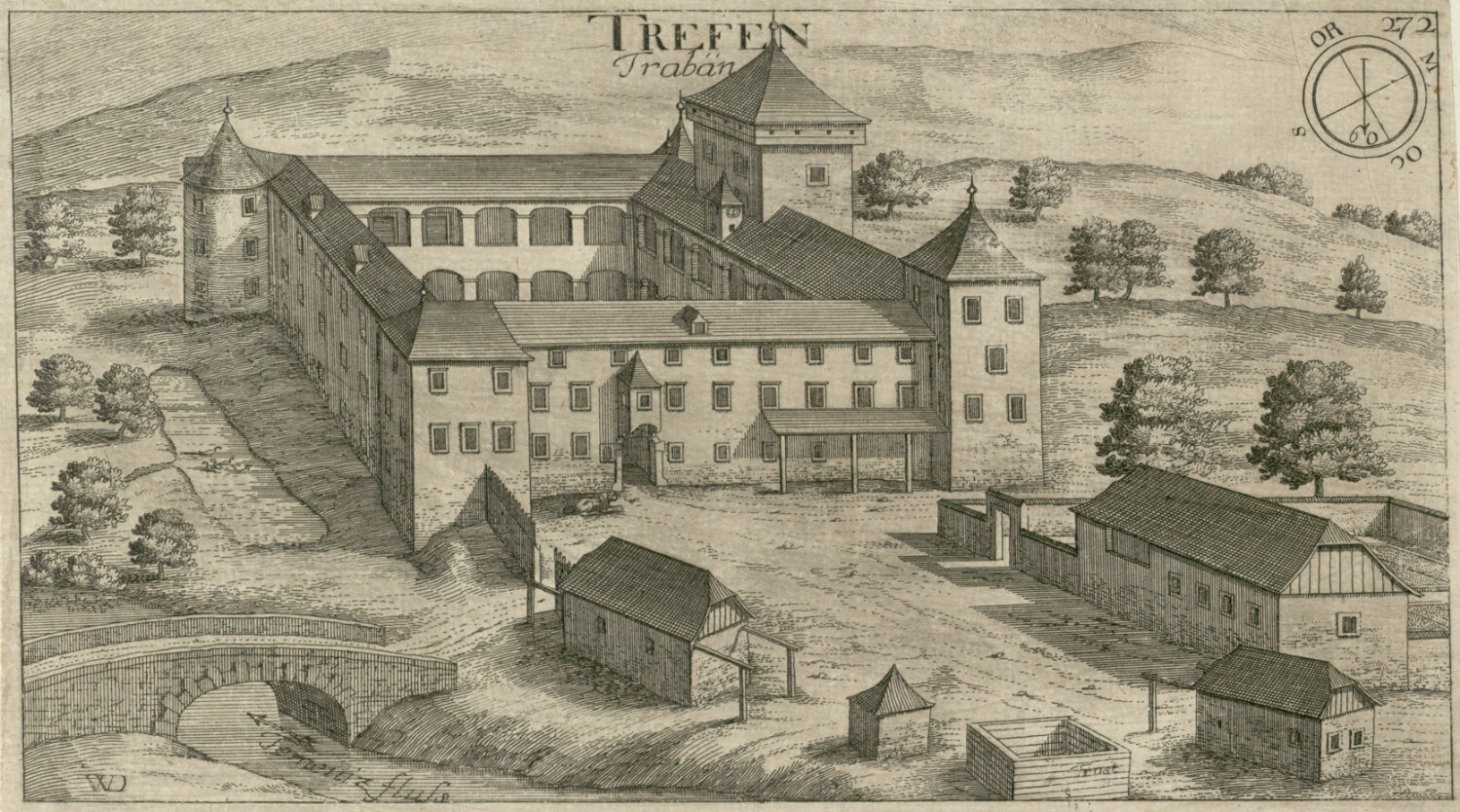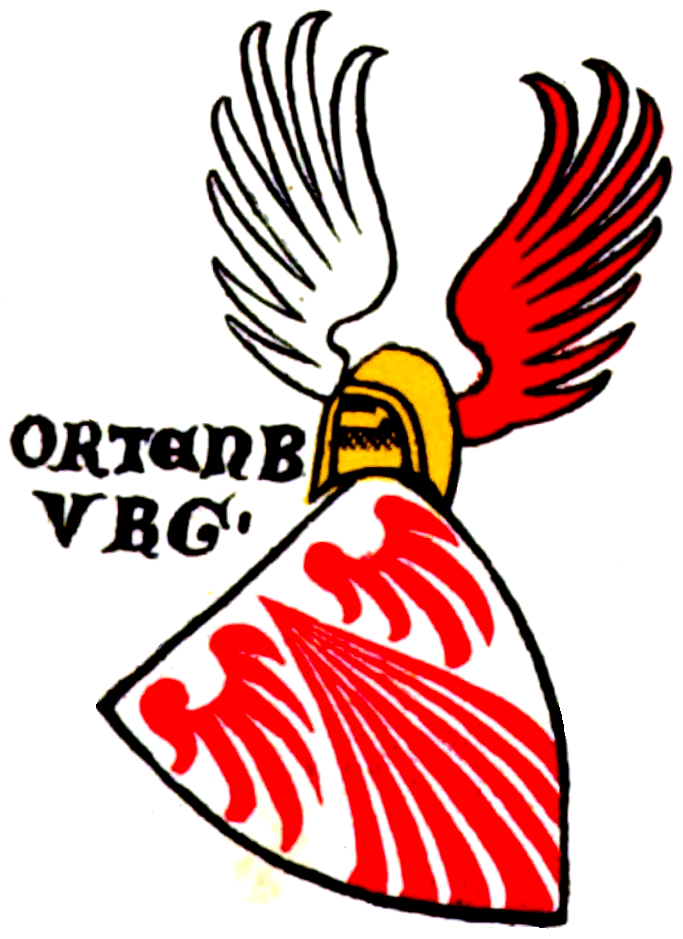|
Trebnje Castle
Trebnje Castle is a smaller castle located in a Slovenian town Trebnje, positioned on a plateau on the right bank of river Temenica. Sources claim that the castle was built around year 1000, which makes it one of the oldest Slovenian castles. /sup> The castle has changed several owners over the years, ranging from local nobility, Habsburgs, and a missionary Frederick Baraga. Today, while the castle's fate remains uncertain, its condition is visibly deteriorating. History It is believed that the castle was built around year 1000 by the Patriarchate of Aquileia and managed by their local vassal knights named de Treuen. Records attest that the castle's first vassal was Konrad de Treuen, who was then followed by Bernard, Henrik and Ulrik de Treuen between the years 1243 and 1245. A record from 1349 mentions the knight Hajncel, and Aquileian charters from 1358 refer to the knight Johannis de Treuen as the castle's overseers. First mentions of the castle however date back to 1386 and 1 ... [...More Info...] [...Related Items...] OR: [Wikipedia] [Google] [Baidu] |
Trebnje
Trebnje (, german: Treffen) is a town in southeastern Slovenia. Trebnje lies on the Temenica, Temenica River in the traditional region of Lower Carniola. The area was already settled in Antiquity. The modern settlement developed on the main regional road and railway line from Ljubljana to Novo Mesto. The old town center with the parish church stands slightly raised on the left bank of Temenica River, and the new part extends to the north from the railway line and the regional road toward Novo Mesto. Trebnje is the centre of the Municipality of Trebnje. Name Trebnje was attested in historical sources in 1163 as ''Treuen'' (and as ''Treven'' in 1228, ''Trefen'' in 1389, and ''Treben'' in 1437). The name is believed to be a clipped form of ''Trěbьńe selo'' 'Trěbъ's village', presumably referring to an early inhabitant of the place. A less likely theory derives the name from the verb *''trěbiti'' 'to clean, clear (land)', thus referring to an area cleared for settlement. Anothe ... [...More Info...] [...Related Items...] OR: [Wikipedia] [Google] [Baidu] |
Temenica
The Temenica is a river in Slovenia. It is one of the most typical influent streams of Slovenia's karst terrain. Name The name ''Temenica'' comes from the archaic common noun *''temenica'' 'spring' (cf. Polish dialect ''ciemienica'' 'spring', Czech ''temenec'' 'spring'). Geography The river goes under the surface twice. It originates in the southern part of the Sava Hills. It sinks for the first time near Dolenje Ponikve in several sinkholes. It emerges again in the Mirna Peč Valley at Zijalo Spring. It runs above ground until a sinkhole near Goriška Vas, where it sinks for the second and last time. The third and last spring of the Temenica is located at Luknja pri Prečni. It flows through the Zalog Karst Field and it joins with the Krka River as its largest tributary A tributary, or affluent, is a stream or river that flows into a larger stream or main stem (or parent) river or a lake. A tributary does not flow directly into a sea or ocean. Tributaries and the main s ... [...More Info...] [...Related Items...] OR: [Wikipedia] [Google] [Baidu] |
Patriarchate Of Aquileia
The Patriarchate of Aquileia was an episcopal see in northeastern Italy, centred on the ancient city of Aquileia situated at the head of the Adriatic, on what is now the Italian seacoast. For many centuries it played an important part in history, particularly in that of the Holy See and northern Italy, and a number of Councils of Aquileia, church councils were held there. No longer a residential bishopric, it is today classified as an Titular Archbishop of Aquileia, archiepiscopal titular see. History From bishopric to patriarchate Ancient tradition asserts that the see was founded by St. Mark, sent there by St. Peter, prior to his mission to early centers of Christianity#Alexandria, Alexandria. St. Hermagoras is said to have been its first bishop and to have died a martyr's death (c. 70). At the end of the third century (285) another martyr, Hilarius of Aquileia, St. Helarus (or St. Hilarius), was bishop of Aquileia. In the course of the Christianity in the 4th century, four ... [...More Info...] [...Related Items...] OR: [Wikipedia] [Google] [Baidu] |
Johann Weikhard Von Valvasor
Johann Weikhard Freiherr von Valvasor or Johann Weichard Freiherr von Valvasor ( sl, Janez Vajkard Valvasor, ) or simply Valvasor (baptised on 28 May 1641 – September or October 1693) was a natural historian and polymath from Carniola, present-day Slovenia, and a fellow of the Royal Society in London. He is known as a pioneer of study of karst studies. Together with his other writings, until the late 19th century his best-known work—the 1689 '' Glory of the Duchy of Carniola'', published in 15 books in four volumes—was the main source for older Slovenian history, making him one of the precursors of modern Slovenian historiography. Biography Valvasor was born in the town of Ljubljana, then Duchy of Carniola, now the capital of Slovenia. In the 16th century, it was Johann Baptist Valvasor who established the family Valvasor in the Duchy of Carniola in central Europe in a part of Austria that is now the Republic of Slovenia. In medieval Latin "Valvasor" or "Valvasore" ... [...More Info...] [...Related Items...] OR: [Wikipedia] [Google] [Baidu] |
Counts Of Ortenburg
The Counts of Ortenburg (german: Grafen von Ortenburg) were a comital family in the mediaeval Duchy of Carinthia. Though they had roots in Bavarian nobility, an affiliation with the Imperial Counts of Ortenburg, a branch line of the Rhenish Franconian House of Sponheim, is not established.Hausmann, Friedrich (1994). "Die Grafen zu Ortenburg und ihre Vorfahren im Mannesstamm, die Spanheimer in Kärnten, Sachsen und Bayern, sowie deren Nebenlinien" in ''Ostbairische Grenzmarken - Passauer Jahrbuch für Geschichte Kunst und Volkskunde''. Nr. 36, Passau 1994. History Little is known about the reasons the Ortenburgs settled in the Carinthian Lurngau. No charters are available on the creation of the Ortenburg Castle on the northern slope of Mt. Goldeck above the village of Baldramsdorf, nor about the manner in which the Ortenburgs obtained their property. In 1072, one Adalbert of Ortenburg, probably a younger son of Count Hartwig II of Grögling-Hirschberg (d. 1068/69), served a ... [...More Info...] [...Related Items...] OR: [Wikipedia] [Google] [Baidu] |
Counts Of Celje
The Counts of Celje ( sl, Celjski grofje) or the Counts of Cilli (german: Grafen von Cilli; hu, cillei grófok) were the most influential late medieval noble dynasty on the territory of present-day Slovenia. Risen as vassals of the Habsburg dukes of Styria in the early 14th century, they ruled the County of Cilli as immediate counts ('' Reichsgrafen'') from 1341 and rose to Princes of the Holy Roman Empire in 1436. History The Lords of Sanneck (Žovnek) Castle on the Sann (Savinja) river in Lower Styria were first mentioned around 1123/30. Their ancestors may have been relatives of Saint Hemma of Gurk (d. 1045), who held large estates in the area. The fortress was allegedly already built under the rule of Charlemagne as a stronghold against the Avars. Counts One Leopold of Sanneck appeared as a supporter of the Habsburg king Rudolf I of Germany in the 1278 Battle on the Marchfeld. In the early 14th century, the Lords of Sanneck allied with the Austrian Habsburgs in the ... [...More Info...] [...Related Items...] OR: [Wikipedia] [Google] [Baidu] |
House Of Habsburg
The House of Habsburg (), alternatively spelled Hapsburg in Englishgerman: Haus Habsburg, ; es, Casa de Habsburgo; hu, Habsburg család, it, Casa di Asburgo, nl, Huis van Habsburg, pl, dom Habsburgów, pt, Casa de Habsburgo, la, Domus Habsburg, french: Maison des Habsbourg and also known as the House of Austriagerman: link=no, Haus Österreich, ; es, link=no, Casa de Austria; nl, Huis van Oostenrijk, pl, dom Austrii, la, Domus Austriæ, french: Maison d'Autriche; hu, Ausztria Háza; it, Casa d'Austria; pt, Casa da Áustria is one of the most prominent and important dynasties in European history. The house takes its name from Habsburg Castle, a fortress built in the 1020s in present-day Switzerland by Radbot of Klettgau, who named his fortress Habsburg. His grandson Otto II was the first to take the fortress name as his own, adding "Count of Habsburg" to his title. In 1273, Count Radbot's seventh-generation descendant Rudolph of Habsburg was elected King of the ... [...More Info...] [...Related Items...] OR: [Wikipedia] [Google] [Baidu] |
Trebnje - Valvasor
Trebnje (, german: Treffen) is a town in southeastern Slovenia. Trebnje lies on the Temenica River in the traditional region of Lower Carniola. The area was already settled in Antiquity. The modern settlement developed on the main regional road and railway line from Ljubljana to Novo Mesto. The old town center with the parish church stands slightly raised on the left bank of Temenica River, and the new part extends to the north from the railway line and the regional road toward Novo Mesto. Trebnje is the centre of the Municipality of Trebnje. Name Trebnje was attested in historical sources in 1163 as ''Treuen'' (and as ''Treven'' in 1228, ''Trefen'' in 1389, and ''Treben'' in 1437). The name is believed to be a clipped form of ''Trěbьńe selo'' 'Trěbъ's village', presumably referring to an early inhabitant of the place. A less likely theory derives the name from the verb *''trěbiti'' 'to clean, clear (land)', thus referring to an area cleared for settlement. Another hypothe ... [...More Info...] [...Related Items...] OR: [Wikipedia] [Google] [Baidu] |
Stična Abbey
Stična Abbey ( sl, Cistercijanska opatija Stična, also ; german: Kloster Sittich, Latin: ''Sitticum'') is the oldest monastery in Slovenia. It is the only Cistercian monastery in the country still operating (the other was Kostanjevica Abbey in Kostanjevica na Krki). Its mother house was Rein Abbey in Austria. History The abbey foundation charter was issued in 1136 by Pellegrinus I, Patriarch of Aquileia, although monastic life had begun a year earlier, in 1135. The monastery at Stična quickly became an important religious, cultural and economic centre. In addition to an ordinary school, the monastery also operated a music school, where the Renaissance composer Jacobus Gallus is believed to have received his earliest musical education. The successful life of the monastery was hampered by Ottoman raids, and was burned and looted twice. In 1784 Emperor Joseph II abolished the monastery, dissolved under the Josephine Reforms, but it was resettled again in 1898 by monks from Me ... [...More Info...] [...Related Items...] OR: [Wikipedia] [Google] [Baidu] |
Frederic Baraga
Irenaeus Frederic Baraga (June 29, 1797 – January 19, 1868; sl, Irenej Friderik Baraga) was a Slovenian Roman Catholic missionary to the United States and a grammarian by and author of Christian poetry and hymns in Native American languages. He became the first bishop of the Roman Catholic Diocese of Marquette, Michigan, originally sited at Sault Sainte Marie, which he led for 15 years. His letters about his missionary work were published widely in Europe, inspiring the priests John Neumann and Francis Xavier Pierz to emigrate to the United States. In 2012, during the reign of Pope Benedict XVI, Baraga was declared "Venerable." Early life Frederic Baraga was born in the manor house at Mala Vas (german: Kleindorf) no. 16 near the Carniolan village of Dobrnič, in what was then Lower Carniola, a province of the Duchy of Carniola in the Habsburg monarchy. Today it is a part of the Municipality of Trebnje in Slovenia. Never using his first name, he was baptized ''Irenae ... [...More Info...] [...Related Items...] OR: [Wikipedia] [Google] [Baidu] |







